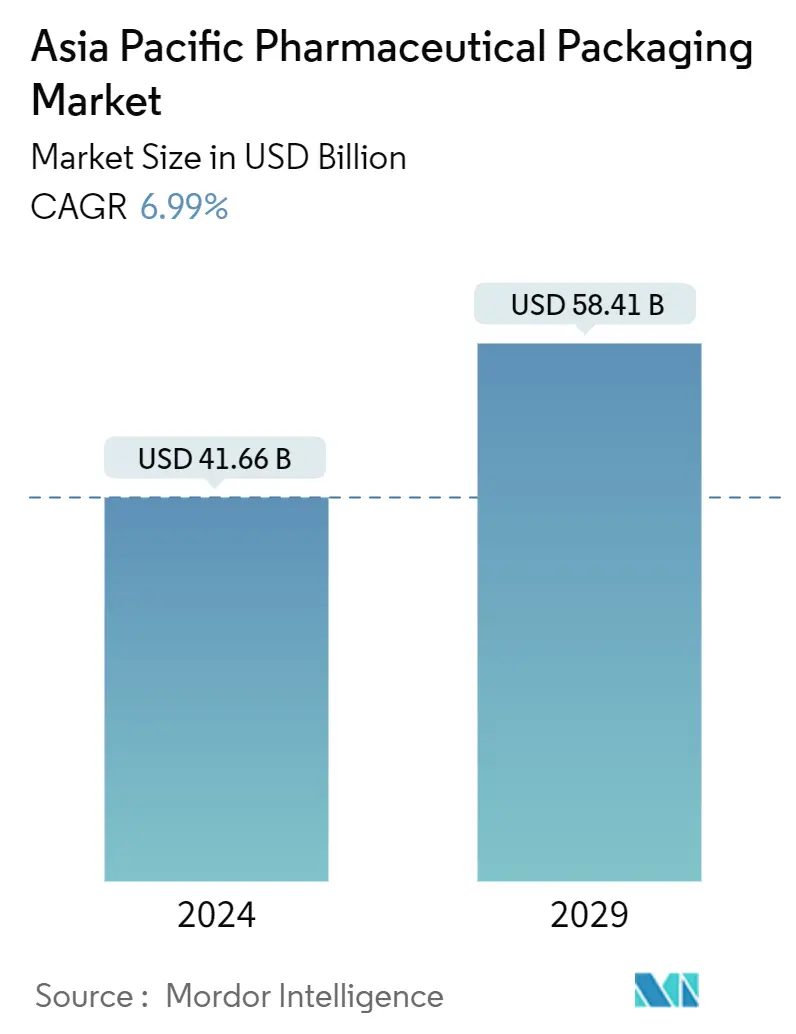Market Size of Asia Pacific Pharmaceutical Packaging Industry

| Study Period | 2019 - 2029 |
| Base Year For Estimation | 2023 |
| Market Size (2024) | USD 41.66 Billion |
| Market Size (2029) | USD 58.41 Billion |
| CAGR (2024 - 2029) | 6.99 % |
| Market Concentration | Low |
Major Players.webp)
*Disclaimer: Major Players sorted in no particular order |
Need a report that reflects how COVID-19 has impacted this market and its growth?
Asia Pacific Pharmaceutical Packaging Market Analysis
The Asia Pacific Pharmaceutical Packaging Market size is estimated at USD 41.66 billion in 2024, and is expected to reach USD 58.41 billion by 2029, growing at a CAGR of 6.99% during the forecast period (2024-2029).
The demand for pharmaceutical packaging is majorly emerging from densely populated economies like India and China. The increasing pharmaceutical production in these countries has been further boosting the demand.
- The Chinese government's policies to accelerate the transformation of the country's medical regime are expected to promote the development of the pharmaceutical packaging sector. Furthermore, China is actively upgrading its pharmaceutical packaging facilities and materials and diversifying its pharmaceutical products, which will likely bring new opportunities to pharmaceutical packaging firms.
- For instance, the Chinese government announced its ten-year 'Made in China 2025' strategic plan to make the country a global leader in several high-tech industries. These industries unexpectedly also included biotech, which was not a particularly strong area for Chinese manufacturing, which is more recognized for generics production. The government has dramatically increased its investment in and support for biotech to stimulate innovation. Advanced biologic production involving cell and gene therapies is currently limited but concentrated in Eastern China in provinces such as Shanghai, Zhejiang, and Jiangsu for US FDA-approved sites.
- The shifting inclination of the manufacturers towards sustainable packaging solutions and partnerships between the market players opting the various way of growth for the market. For instance, in December 2022, Four Japanese drugmakers, Astellas, Eisai, Daiichi Sankyo, and Takeda, joined a partnership to reduce the environmental impact of pharmaceutical packaging. The collaboration comes as the pharma industry is increasingly having to face up to its effect on the environment after years of avoiding scrutiny of its impact as a significant manufacturer of goods.
- Increasing advancement of technology in the packaging solutions of pharmaceuticals to provide advanced usages to the packaging solutions of medicines is further increasing the market's growth. For instance, the current advancement of the packaging design field, like zip lock bags, is lightweight and compact in securing medicine. Furthermore, the future of prefilled syringes will give patients hassle-free and subcutaneous options for drug delivery.
- Moreover, aluminum and glass have traditionally been the preferred materials for pharmaceutical packaging. Over time, these materials became too expensive (due to raw material prices and other factors) to provide a commercially viable solution for packaging high-volume products, marking the demand for plastic materials in the industry.
- The outbreak of the COVID-19 pandemic had a considerable impact across various industries, including the packaging industry, as the widespread lockdown and restriction on workforce utilization in factories significantly impacted demand and production and disrupted the supply of finished goods. The COVID-19 pandemic directly affected production and demand, disrupting pharmaceutical supply chains and logistics. As the industry shifted focus and prioritized infectious diseases and vaccines, successful clinical trials and R&D activities in therapeutic areas, such as diabetes and hypertension, decreased. However, the pharmaceutical industry recovered quickly with the need for safe and hygienic packaging during the pandemic. Further, the Russia-Ukraine war has an impact on the overall packaging ecosystem.
